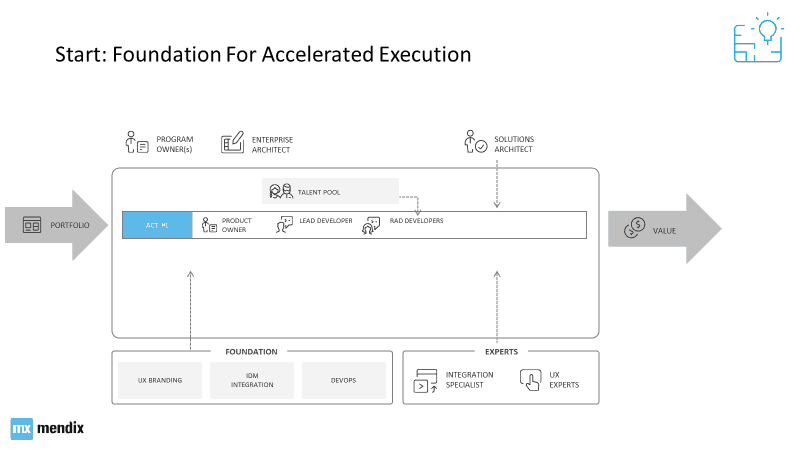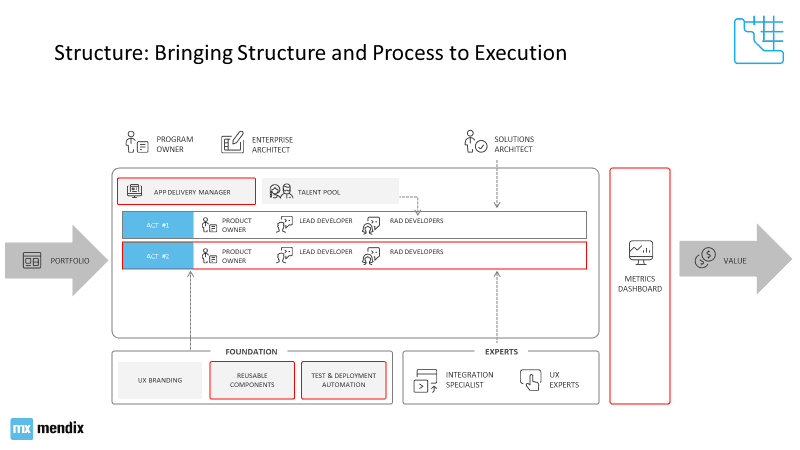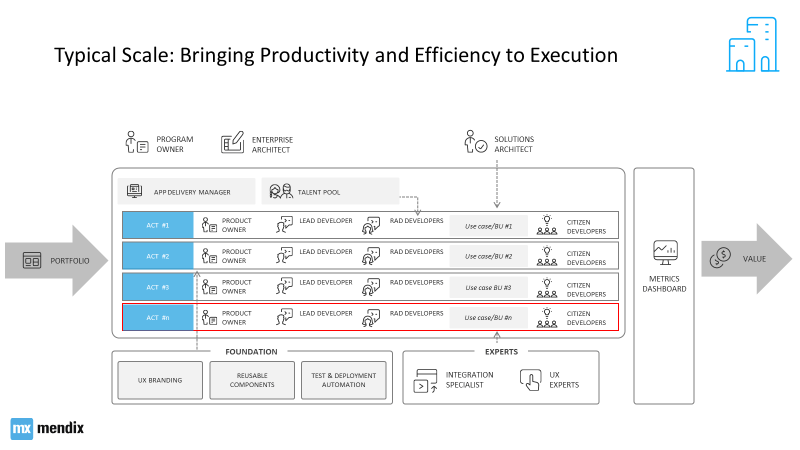In a recent post, I stated that changing the way you deliver software is the key to executing digital transformation (or digital execution). This means changing your development techniques and your DevOps pipelines along with the way you collaborate.
Your applications are what bring your company value. Simply put, you need to make them and you need to do it quickly and efficiently. Making apps at that speed starts with building your Innovation Factory — a structured, repeatable, scalable way of manufacturing and delivering innovation. It’s a means by which you activate your people and change your processes to create an application portfolio…all at scale.
Sounds easy, right? Sarcasm aside, we understand there’s a lot of work that goes into scaling up application development. But at Mendix, we’ve got the blueprints to help you build your Innovation Factory. It all starts by asking yourself three questions and avoiding one.
Asking What IF?
The first question you want to ask yourself is “What now?” What is it that you can do now to quickly start incorporating meaningful change in your IT organization? What can you do now to get the cogs moving in the digital execution machine? The answer to this question is adopting a low-code platform like Mendix to help you with rapid application development.
The second, subsequent question is “What’s next?” You’ve adopted Mendix and maybe your team has built an app or two with it, but ask yourself what is it that you have to do to keep the momentum going and keep making positive, meaningful change to your application development process and your organization as a whole?
But just purchasing new software and expecting to be transformed is short-sighted and it can lead to the question you need to avoid: “Now what?”
“Now what?” is a growth blocker. It’s defeating and lacking vision. “Now what?” tamps down any value you could derive from a powerful tool like a low-code platform. “Now what?” can shut down and undo any of the change that you’ve worked so hard to make happen.
So, instead of asking “Now what?” ask yourself the third question: “What IF?”
That’s not a typo. For us “IF” stands for the head-first dive into the exciting unknown of new technologies and processes. “IF” is the possibility of what can happen when you change the way you work. “IF” is the envisioning of a future where innovation isn’t a distant thought, but manufactured and delivered in a structured, repeatable, and scalable way. “IF” is the Innovation Factory.
Your Innovation Factory starts with your vision
Let’s say you want to go to Paris for a vacation. You don’t just go to the airport and fly to Paris. You could, but the likelihood of you getting a flight when you want it is slim, the chances of you finding a hotel on a whim are very low. Instead of that dream vacation, you’re scrambling around the streets of Paris stressed out and looking for a place to sleep. It’s a disaster.
Much like that trip to Paris, changing the way you deliver software requires planning and vision setting to avoid stress.
When you start out with rapid application development with low-code, your vision is the most important aspect. The vision you set for a number of apps or their mission-criticality determines the amount of ROI you’ll receive. Start thinking of your Innovation Factory at the very beginning of your rapid application development journey. The results you get from your first team using a low-code platform will determine the course of your digital execution journey and the ROI you receive.

The construction of your Innovation Factory has three main stages. Which stages you go through and how fast is up to you and your vision. But here are all three stages, the requirements to get through each, and the optimum timeline for moving to a scaled-up app development process.
Start (Months 1 and 2)
No matter your vision for rapid application development, you have to start at the very beginning. The first two months are about finding your team and planning for the next stage.
The requirements found in Start are designed to help you deliver value as soon as possible. In this stage, you are building the foundation for accelerated growth. To do this, you first create a small team and train them on a low-code platform. Your first team needs to consist of a product owner, business developers and professional developers that have been trained on low-code. Accelerators like a user experience (UX) expert or a solutions architect are nice to have as well.
The key to a good first team is your product owner. Your team is only as strong as the product owner, so when choosing one, make sure that person has a very good sense of the business and the business problems you’re trying to solve. Because that will inform the applications you develop.
The applications you develop at the Start stage should have:
- Low complexity- Apps that have fewer requirements and dependencies on other systems are much easier to deliver.
- High exposure- Build an app that you know is going to be a highly touted solution to a business problem.

The Start stage results in two things: value delivered quickly, and the plan for team growth. Before you move onto the next stage, you should have the next group of developers and product owners in mind so you can split teams. Beyond people, you’re also developing reusable components and beginning to document best delivery practices to ensure that there is a repeatable process in place for the next stage of building your Innovation Factory.
See how the automotive technology company, Continental, is starting out with Mendix and establishing a vision to move to Structure and Scale.
Structure (Months 3-5)
In Start, you proved your success. You experimented, you failed a few times, you learned, and then made rapid application development a reality. You created the foundation for your Innovation Factory. Now its time to start fast, efficient production.
A key component of developing rapidly at scale is quality control, repetition, and automation. In Structure, your goals are to develop and formalize re-usable processes, drive governance, and automate a deployment process.
You grow your team in Structure. In Start, your team was purposefully small so that you could learn fast. Now, you’ll want more teams doing that work because your portfolio is going to grow as well. By the end of Structure, you should have multiple teams that have received advanced rapid application development training and are knowledgeable of the technical and functional governance that’s established during Structure. The experts train the new developers, who in turn become experts and can train the next group of new developers. This ensures that when teams split to do work, there’s always an expert and there’s always learning.

During the Structure stage, you will start to develop apps that are more complex and will gain more exposure. The apps’ use cases will expand, addressing more business problems. You can almost hear that ROI increasing.
Another aspect of Structure is creating a metrics dashboard so you can start to monitor the health of your application portfolio. With this, you can answer questions around how many users does the app have, how many releases, what’s the health of the team, and so on. It’s important to start measuring these things as you move onto to Scale.
Check out how Enexis became the holder of the world’s largest low-code application portfolio by methodically moving from Start to Structure, and set themselves up for a successful move to Scale.
Scale (Month 6 and beyond)
Scale is Structure, just multiplied. When your innovation Factory is at Scale, you’re taking the work of those two to four teams you built through Start and Structure, and you’re proliferating that across the organization.
With low-code, you don’t have to rely on just business and professional developers to build solutions. There are technically savvy people – citizen developers — across your organization who, with the right amount of guidance and training, can start solving business problems themselves.

PostNL and Canada Post are starting out their Mendix journeys at Scale. See how they set their visions for their companies.
The Innovation Factory is an organizational function by which professional and citizen developers can experiment and explore (i.e., innovate) and also create apps and deliver value quickly. That value or success drives change. When you master change, you’ve unlocked digital transformation.
Where do you go from here? Well, you could ask yourself “Now what?” but that won’t get you anywhere. Instead, ask yourself “What IF?” and click the banner below to get your answer.
